The Matterhorn - most famous peak of the world

What would be Zermatt without its Hörnli? What would be the whole mountain world around Zermatt without the highest mountain of the world? Would somebody go up the Gornergrat at all, only to gaze at the surrounding four-thousanders and a few glaciers? The highest mountain of the world does exist, the most dangerous and difficult one. But the most famous mountain of all over the world is, without doubt, the Matterhorn. By showing a picture of the Matterhorn to somebody from another place of the earth, it gets rapidly clear what kind of a summit is in question. Finally, the Matterhorn-symbol is spread all over the world by the Swiss people through many products; there is only to think of the toblerone-chocolate that is available at almost any international airport. (Who likes this chocolate actually?)
Why is the Matterhorn so famous?
Why did the Matterhorn actually vbecome the most famous mountain of the world? What kind of features are those that made it to be so famous and popular? By comparing the summit of the Matterhorn with the one of the Dent Blanc from a distance, (white tooth), that is locted right beside the Matterhorn, there are berely differences noticeable in the profile. And there are some further mountain in the area of Zermatt that have a similar, pyramid-shaped summit profile as the Matterhorn.
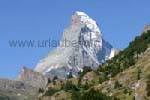
Of course, it is the distinctive shape that makes the Matterhorn to be so famous. Its edges seem to be accurately grinded with a giant knife. But it is not only the shape that provides the Mont Cervin (this is the way the mountain is called after the Italian village Cervinia) fame and glory, it is specially also its situation, as the Matterhorn stands in a mountain landscape, as an open space was generated amidst the high mountains in order to put there a distinctive mountain. The Matterhorn stands on a basement heighted 2000, from which the mountain itself rises steeply and slim to the sky.
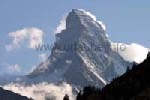
If I wondered at the beginning what Zermatt would be without its Matterhorn, I have also to ask conversely, what the Hirli (local expression for Matterhorn) without Zermatt, its meadows and forests would be. When I saw the Matterhorn from the summit of the Klein Matterhorn, I was quite disappointed by the view. Indeed, a mighty and well-shaped summit was in front of one, but it was not really outstanding from the surrounding mountain world, as it is usually the case in the pictures of the postcards.
In fact, primary the beautiful tributary valleys of Zermatt, the colourful meadows and forests as also the historical Walser houses provided the Matterhorn this romantic and picturesque ambient that is generally known. How beautiful is the picture of the Hörnli, when there are some colourful meadows and a few trees in front of it, contrary to a picture of the Matterhorn on which there are only rocks, summits and glaciers around!
The structure of the Matterhorn
By watching the Matterhorn closely, one detects that the summit consists on two floors. The mountain has three basic flanks with three shoulders that carry the upper summit. While the flanks of the upper summit area rise almost vertically in direction to the sky, the wide shoulder flanks thereunder are less steeply. The upper summit area is often called the roof of the Matterhorn.
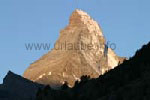

In fact, the mountain does not only have a two-staged looking, but also consists geologically on two different stone layers. Indeed, both layers are consist on gneiss, but the upper one is significantly harder than the lower one. This is also the reason why the flanks of the lower area are not as steep as the ones of the upper area. While the upper area is hard and firm, in the lower area, there are repeatedly erosional movements: oftenly, there are rockfalls that push the piles of rubble downwards. Thus, the erosion constantly gnaws at the beautiful summit.
At the sides of the mountains, there are numerous little cavities, in which, in case of raining or during the snow melting, water is accumulated. Once this water is frozen and melts again, it can blast the rocks thereunder which also then causes rockfalls.
Actually, the Matterhorn has two summits where a cross is standing in between. The country Swiss-Italin border runs between this both summits. The Swiss summit heighted 4478 m is exactly 1,10 m higher than the Italian summit. The Italians call their mountain, by the way, Monte Cervino, the French name is Mont Cervin.
How whas the Matterhorn originated?
How could the nature actually produce such a beautifully formed mountain as the Matterhorn? This mountain seems to be produced by human hands and put afterwards into the mountain world. First, there is to get back into the geological history, to the tertiary, thus umpteen millions of times into the past. In that time,
the Alps were originated. The African tectonic plate moved up the eurasian plate. It is obvious that this development was caused by countless earthquakes.
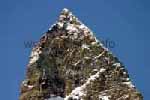
Thus, during this plate collision, the earth material piled to what today are the Alps. The different layers cut several times across each other, so that still today, complete different rock formations that are piled on each other are visible in the Zermatt area.
Thus, the Alps were generated as new mountains. What is amazing is that still today, the whole mountain chain from the Matterhorn up to the Weisshorn are located on the African tectonic plate, while the mountain chain from the Dom up to the Breithorn is located on the European tectonic plate. The Matterhorn is geographically indeed located on the European continent, but geologically, it is standing on an African tectonic plate.
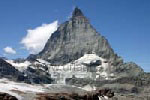
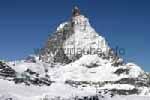
Now, who has grinded the edges of the Matterhorn so smoothly, this cannot be produced by coincidence by the collision of the tectonic plates, or is it? By getting one epoch further in the geological times in to the quarternary; we are talking about the time period of the last two million years. As know, this epoch was marked by hard glacial periods. It is hard to imagine, but the Alp glaciers went far into the middle of France. All Alp valleys were filled with ice; in the coldest times, only the four-thousanders rised out of the ice, and this is barely some hundred thousand years ago!
What today applies for the "little" glaciers, of course, it also does apply for the big glaciers of the glacial period: they carried moraines about with them, polished and grinded the area. If today some pieces of rock fall from the Matterhorn as a result of the erosion, it is harmless compared to the erosive deformations that were generated during the glacial period underneath the glacial ice.
Thus, the big glaciers of the glacial times were the ones that gave the Matterhorn its symmetrical shape of today.
Visit to the Matterhorn
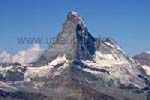
Why is there actually no gondola that leads up to the mountain of all the mountains? For the Swiss constructors of mountain trains and gondolas, this would be not a technical problem. But what would be the benefit of standing on the most beautiful summit of the world? One would have almost the same panorama as the one from the Klein Matterhorn, only the east side would be covered by the even higher summits of the Dom, the Monte-Rosa-Group and the Lyskamm. But the most important thing would be missing: one would not see the most beautiful summit of the world, as one would be right standing on it. Additionally, a summit train of the Matterhorn would only be useful to get to an observation deck, as there is no ski-run possible at the Matterhorn at all.
Thus, there are numerous gondolas leading to all possible points in the area of Zermatt. One can gaze at the Matterhorn-peak from all perspectives. But I stick to the idea that the Matterhorn is the most beautiful from below, by looking over the colourful forests and meadows up to the mountain of the mountains.

Back to the index Zermatt
Copyright: Patrick Wagner, www.tourist-guide.biz
|